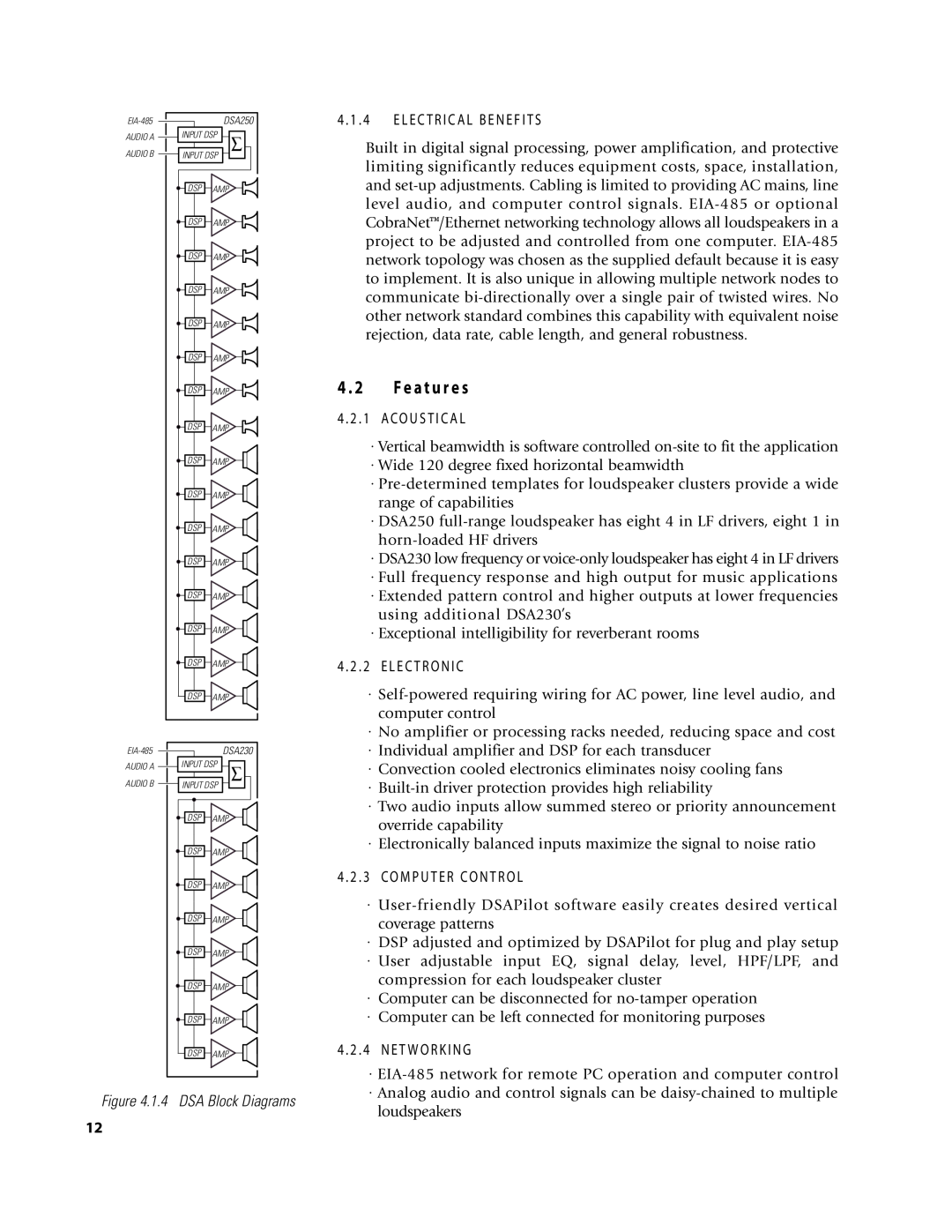
| DSA250 | 4 . 1 . 4 | E L E C T R I C A L B E N E F I T S | ||
AUDIO A | INPUT DSP | ∑ | Built in digital signal processing, power amplification, and protective | ||
AUDIO B |
|
| |||
INPUT DSP |
| ||||
| limiting significantly reduces equipment costs, space, installation, | ||||
|
|
|
| ||
| DSP | AMP |
| and | |
|
|
|
| level audio, and computer control signals. | |
| DSP | AMP |
| CobraNet™/Ethernet networking technology allows all loudspeakers in a | |
|
|
|
| project to be adjusted and controlled from one computer. | |
| DSP | AMP |
| network topology was chosen as the supplied default because it is easy | |
|
|
|
| ||
| DSP | AMP |
| to implement. It is also unique in allowing multiple network nodes to | |
|
| communicate | |||
|
|
|
| ||
| DSP | AMP |
| other network standard combines this capability with equivalent noise | |
|
| rejection, data rate, cable length, and general robustness. | |||
|
|
|
| ||
| DSP | AMP |
|
|
|
| DSP | AMP |
| 4 . 2 | F e a t u r e s |
| DSP | AMP |
| 4 . 2 . 1 A C O U S T I C A L | |
|
|
|
| ||
| DSP |
|
| ·Vertical beamwidth is software controlled | |
| AMP |
| ·Wide 120 degree fixed horizontal beamwidth | ||
|
|
|
| ||
| DSP | AMP |
| ||
|
|
| range of capabilities | ||
|
|
|
|
| |
| DSP | AMP |
| ·DSA250 | |
|
|
| |||
|
|
|
|
| |
| DSP | AMP |
| ·DSA230 low frequency or | |
|
|
|
| ·Full frequency response and high output for music applications | |
| DSP | AMP |
| ·Extended pattern control and higher outputs at lower frequencies | |
|
|
|
|
| using additional DSA230’s |
| DSP | AMP |
| ·Exceptional intelligibility for reverberant rooms | |
|
|
|
| ||
| DSP | AMP |
| 4 . 2 . 2 E L E C T R O N I C | |
|
|
|
| ||
| DSP | AMP |
| · | |
|
|
|
|
| computer control |
·No amplifier or processing racks needed, reducing space and cost
| DSA230 | · Individual amplifier and DSP for each transducer | ||
AUDIO A | INPUT DSP | ∑ | · Convection cooled electronics eliminates noisy cooling fans | |
AUDIO B |
|
| ||
INPUT DSP |
| · | ||
|
|
|
| |
| DSP | AMP |
| · Two audio inputs allow summed stereo or priority announcement |
|
| override capability | ||
|
|
|
| |
| DSP | AMP |
| · Electronically balanced inputs maximize the signal to noise ratio |
|
|
| ||
| DSP | AMP |
| 4 . 2 . 3 C O M P U T E R C O N T R O L |
|
|
| ||
| DSP |
|
| · |
| AMP |
| coverage patterns | |
|
|
|
| |
| DSP | AMP |
| · DSP adjusted and optimized by DSAPilot for plug and play setup |
|
| · User adjustable input EQ, signal delay, level, HPF/LPF, and | ||
|
|
|
| |
| DSP | AMP |
| compression for each loudspeaker cluster |
|
| · Computer can be disconnected for | ||
|
|
|
| |
| DSP | AMP |
| · Computer can be left connected for monitoring purposes |
| DSP | AMP |
| 4 . 2 . 4 N E T W O R K I N G |
|
|
|
| · |
· Analog audio and control signals can be
Figure 4.1.4 DSA Block Diagrams
loudspeakers
12
